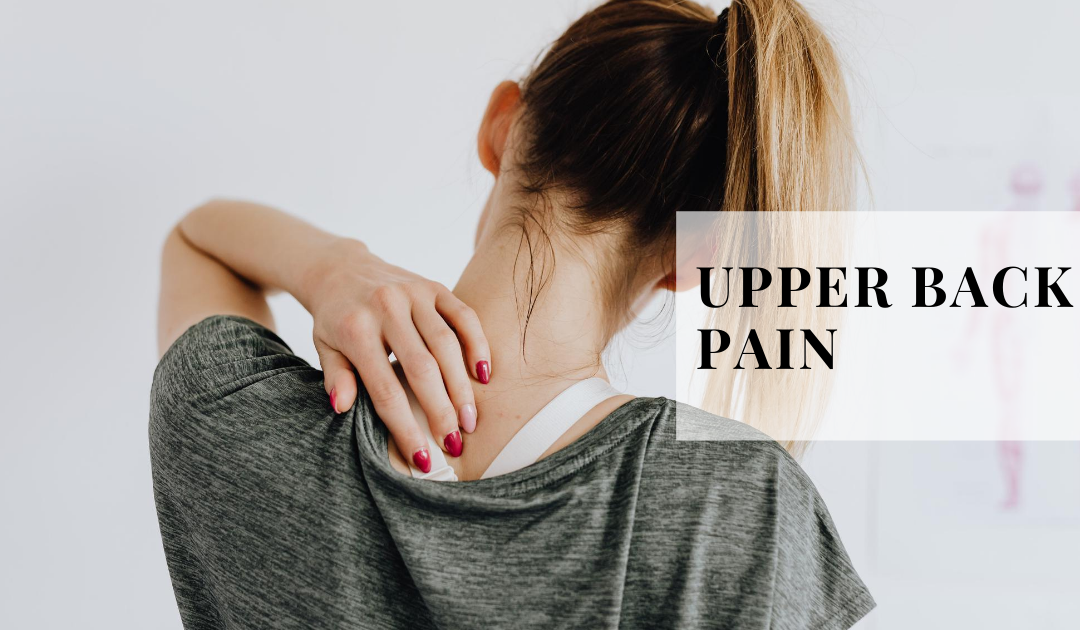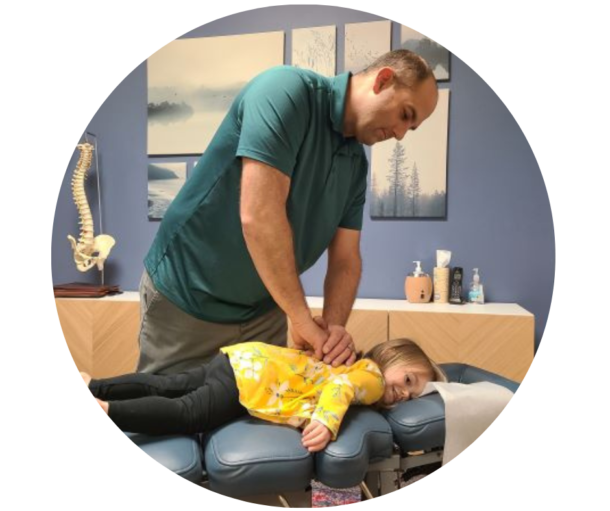Upper Back Pain
Have you ever had pain between the shoulders that did not seem to go away? This nagging upper/mid back pain can interfere with your concentration at work, school, social life, and can even have an impact on your mood around other people. When patients come into our office with upper back pain, they will typically say things like “It hurts between my shoulders when I bend forward,” “Anytime when I am twisting to do something I really notice my pain,” or “Ever since I had my child I started to notice my midback pain.” Upper back pain involves the joints and muscles of the spine and has a high success rate when treated with conservative approaches, such as, chiropractic, physical therapy and massage therapy. It is also important to be aware of other factors contributing to your upper back pain including, sleeping positions, your mattress, the way you are bending/moving, your dog tugging on his/her leash while walking, and other factors.
Upper/mid back pain (thoracalgia or dorsalgia) can commonly be caused by the area between the joints of the upper back, referred to as the intervertebral discs. In prolonged and intense exertion during sports activities, can lead to structural changes and functions of the muscles and joints, requiring more time with rehabilitation for athletes (1).
The mid back (thoracic spine) functions to give support to the rib cage. Muscle irritation and joint dysfunction are the typical reasons why upper back pain occurs. Pain can be felt as a sharp, burning, localized to one area, or general achiness sensation. The pain commonly can spread to the shoulders, neck, or other areas of the body. One study (involving workers throughout various professions) showed that 9% of men and 17% of woman experience upper back pain (2).
Upper back pain is usually a result of poor posture or bending/twisting the wrong way. Certain jobs that involve sitting at a desk for long durations of time can cause upper back pain. Motions that involve reaching forward, such as, factory work, usually causes upper back pain.
When should you be concerned with your upper back pain?
Most of the time upper back pain is due to problems with the joints and muscles; however, there are some cases that the pain could indicate another cause. Some of these causes include infection of the spine, cancers, spinal instability causing problems to the nerves or spinal cord, and other causes. Some of the symptoms of these disorders include traveling pain, sensations of pins and needles in the chest or abdomen, fever or chills, severe headaches, or difficulty walking. Upper back pain resulting from trauma, such as, car accident, fall from a ladder, or other types of trauma, should always be evaluated (2).
Common Upper Back Pain Symptoms
- The pain experienced from upper back pain can have a sharp sensation. This type of pain can feel like a knife-like, burning, or gripping sensation. This type of pain will be more localized.
- General discomfort with an achy/throbbing sensation and may spread into the neck, shoulders or even the lower back.
- Reduced mobility/stiffness within the upper back, which could moving the arms and lifting more difficult.
- Traveling/radiating pain can follow along a nerve of the upper back into the arm, chest, or stomach. This will often feel like a dull, sharp, or electrical pain. This pain is typically felt in only one side of the body.
- Pins and needles sensation traveling from the upper/midback and going around the ribs. Pain can be felt as tingling, numbness, or weakness.
Statistics and Facts:
- One study showed that 10% of students reported upper back pain that interfered with school or leisure activities (3)
- Mid back pain is less common than lower back pain or neck pain, due to the more rigid structure of the mid back
- Midback pain is commonly caused by muscle injury, poor posture, disc problems or arthritis
- Symptoms include dull, burning, muscle tightness, stiffness, or sharp pain
- Serious symptoms of upper back pain include weakness in your arms or legs, numbness or tingling in your arms, legs, chest, or abdomen, or loss in bowel or bladder control (6)
Exercises:
Strengthening the supporting muscles around the upper and mid back can help to reduce pain within the joints. Some exercises you can do to help strengthen these muscles include seated rows, lat pull downs, scapular squeeze, superman…etc. These exercises can help the muscles support the joints of the upper back and reduce pain.
With so many people texting on cell phones and working on computers, poor posture can be a contributing factor with upper back pain. Posture exercises include Brugger’s exercise which you will sit straight, roll shoulders back and down, rotate the palms of your hands out and at your sides, and slide your chin backwards. Maintain this position for about 15 seconds multiple times throughout the day.
Stiff joints that are not moving well can contribute to inflammation, resulting in upper back pain. Flexibility exercises can allow your joints to have more range of motion, which can reduce inflammation. Some exercises you can do at home include cat camel/cat cow, thread the needle, child’s pose…etc.
Chiropractic for upper back pain:
Chiropractic treatments are a natural form of health care and can help upper back pain. The joints in the spine can become restricted and limit motion, resulting in pain. Since the purpose of chiropractic treatments is to increase movement, pain and inflammation can be reduced. Other therapies are often combined with chiropractic adjustments to reduce inflammation and muscle tension (electric stimulation, ultrasound…etc). At home stretches to further enahance treatment progress are given to patients. Stretches help to increase the flexibility of the spine and reduce inflammation.
Structural problems and other aggravating factors:
We have natural curves in our spine to reduce stress on the joints of the spine. The normal curve of the upper and mid back is called kyphosis. This is a reverse curve of the spine (viewed from the side) and can cause problems if the curve is excessive (hyperkyphosis) or decreased (hypokyphosis). This can have an impact on the joints and muscles of the mid/upper back, resulting in pain, numbness, and/or tingling.
Curves of the spine looking at the sided of the spine are called kyphosis (reverse curve) and lordosis (forward curve). Looking at the spine from front to back (or back to front) should appear to be a straight line. Any excessive bend from this straight line can be considered as scoliosis. Scoliosis can have an impact on all areas of the spine, creating painful movements. This disorder of the spine can be managed through exercises, special braces for the spine, and chiropractic; however, in extreme circumstance may require surgery (especially when the curve is excessive enough to cause problems with breathing).
Spending excessive time on the computer while sitting at a desk can produce upper back. Certain professions are more at risk for upper back pain, such as, computer programmers, hair stylist, and factory workers. Any profession involving a reaching forward motion for a long duration of time, is going to put more stress on the mid/upper back.
Women who are nursing are at more risk for upper back pain, especially if they are not properly supported with pillows to resist stress on their upper back. Lifting infant car seats in and out of the car can cause stress on the mid/upper back and shoulders. Transporting an infant immediately into a stroller from and to the car, can reduce stress on the shoulders and mid/upper back. Always try to look at your movement and try to take strategies to help reduce the stress on your mid/upper back.
References:
1.) Shpakou, Andrei and Dmitriev, Alexey. April 24, 2013. Short Communication Open Access Actual Aspects of Treatment and Rehabilitation of Athletes with Back pain. International Journal of Physical Medicine and Rehabilitation. Department of Sports Medicine and Rehabilitation, Yanka Kupala State Univeristy of Grodno, Grodno, Belarus.
2.) Sellers, Talbot. All About Upper Back Pain.
3.) Briggs, Andrew M, et. Al. June 29, 2009. Thoracic spine pain in the general population: Prevalence, incidence and associated factors in children, adolescents and adults. A systematic review. BMC Musculoskelet Disor. 2009; 10:77.
4.) Blahd, WilliamUpper and Middle Back Pain. University of Wisconsin Madison School of Medicine and Public Health. June 26, 2019.



Recent Comments